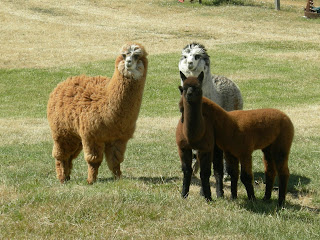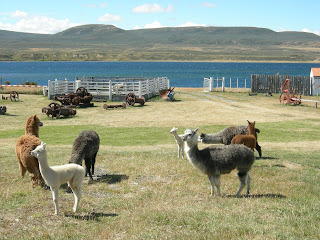
The following is an excerpt from the literature supplied by Princess Cruises.
"Punta Arenas (Sandy point) is the southern most city on the South American mainland. The city has enjoyed two heydays. The first lasted from about 1850 to 1914 when it was the principle coaling and supply station for ships rounding the Horn, as a major world supplier of wool. It was also, by virtue of its strategic location, one of the busiest ports in the world. Its first golden age ended in 1914 when the Panama Canal opened and ships no longer needed to round Cape Horn. (This is also what lead to the decline of Valparaiso) The situation grew worse as wool from New Zealand and Australia began to compete with its major product.
Punta Arenas languished until oil was discovered nearby in the 1940's and with the subsequent improvement in roads, it has recovered its previous status as an important commercial centre as well as a popular destination for tourists interested in exploring Patagonia.
Punta Arenas is the capital of the Magellanes Province, named for Ferdinand Magellan, whose ship was literally blown through the strait that also bears his name by a series of gales in 1520. The first European to see the windswept shores, he was so relieved to see the calmer water to the west of the strait, that he gave it a name we still use - Pacific Ocean."
(The blue lines have nothing to do with our trip. The map is just a little closer look at the area. TheStrait of Magellan is visible, as is the location of Punta Arenas)
-b700w.gif)
The Strait of Magellan was important for shipping for at least two reasons. Firstly, it was considerably shorter that sailing around Cape Horn. Secondly, the water was much more calm in the Strait than it was around the Horn. However, extremely high winds and the narrowness of the channel made it a dangerous place for sailing ships, and many were lost. It was the advent of steam ships that made the Strait of Magellan a safer, and therefore more viable, route to the Pacific.
And so . . . this is Punta Arenas from a hill that overlooks the city of 120,000 people.
(Our Star Princess is the ship to the left)

My Star Princess is on MY left!

The focal point of the city is the Plaza de Aramas. As you might expect, in the centre of the plaza is a statue of Ferdinand Magellan perched on a galleon cannon.

On the opposite side of the statue is a mermaid and two reclining Indians. Rubbing the big toe (actually . . . you are supposed to kiss it . . . yuck!) of one of the Indians will apparently ensure a return to Punta Arenas in the future. We'll see!

Just outside of the plaza is this hotel that used to be the home of a wealthy resident. We found the city to be clean and seemingly prosperous.

However, we didn't spend much time here as we spent most of the day on a road trip to the Estancia FitzRoy (FitzRoy Ranch). The Estancia FitzRoy is a working sheep ranch about a two hour drive north of the city. Interestingly, the owner of the ranch is also the owner of the bus company that organizes the various tours in the area. I guess that's called diversification.
The trip to the ranch gave us a chance to see the countryside.

This part of the world is known for its high winds which can reach almost 200 kilometeres per hour. Evidence of that can been seen by looking at the way the trees grow.



Winds tend to be higher in the summer months. Therefore, we were lucky to have chanced upon a very nice summer day.
Some local wildlife also made an appearance for us. These are Lesser Rheas and are very similar to Ostriches.

They roam wild and are fairly common. Now . . . listen up guys and gals! The males take several (6 - 10) partners to mate with . . . and while that may sound like fun . . . it comes with a heavy dose of responsibility. The females all deposit their eggs in the one nest of the father and then take off! The male sits on the nest, hatches the eggs, and raises the young . . . all of them!

This is a Lesser Rhea's egg that our tour guide had on the bus.

On the way to the ranch, we also saw a gray fox, an eagle . . . and a goucho with his dogs!

Across the channel is the 12,000 acre FitzRoy Estancia. It's located on Isla (Island) Riesco. The island is named after a former Chilean president.

How does one get a bus to an island without a bridge?
You catch the ferry of course!

Just in case you were wondering how the ranch came to be named, here is the answer. Robert FitzRoy was the captian of the Beagle. The Beagle was the ship that Charles Darwin used while exploring this part of the world in the early 1830's.
And just in case you were wondering exactly where we were . . .


I hope that helps to pinpoint our location for you!
The ranch was proudly flying two flags . . . Chile of course . . . but also the regional flag of the Magellanes Province. The stars represent the Southern Cross: The blue represents the sky and the ocean: The jagged white line represents the Andes and their snow covered peaks: The yellow represents the "steppe" or the grasslands of the area.

At the start of the blog, I mentioned that we felt like we were in Saskatchewan. Does this not remind you of being in the Qu'Appelle Valley??!!

How about on a farm along the shore of Lake Diefenbaker? And is that a John Deere tractor?

And a John Deere seeder?

You bet it is!

We've all seen steamers like this in rural Saskatchewan.

Aside from being a sheep rancher and a bus line operator, it seems that the owner is also a bit of a collector.

Not only farm equipment, but wood stoves . . .

. . . and almost anything old that he can get his hands on . . .

. . . including hundreds of kettles.

This large shed also served as the main building for shearing the sheep. This demonstration was done using the old style hand shears . . . no electric clippers here!

The clip took about 10 minutes and reminded me of a hair cut that I got in Valparaiso . . . very short!

Ideally, the wool will come off in one piece.

In this part of the world, a sheep is sheared once a year for about 5 years. Why only 5 years? Apparently the grass is very hard and wears the sheep's teeth down. After about 5 years, they can't eat very well and therefore the quality of the wool isn't very good. I'll let you guess what happens to the sheep once they are no longer producing good quality wool. OK, I'll give you one clue . . . LUNCH . . . but that comes later on in the story.

Speaking of wool . . . In Spanish, wool is "lana". Therefore, the oil in the sheeps' wool is . . . lanolin . . . commonly used in skin lotions, shoe polish and water proofing products. The quality of the wool can be tested after the shearing by taking a small piece and gently tugging the two ends. If the strands break easily, the wool is of poor quality and will fetch a lower market price.
After shearing, the wool is put into a press . . .

and bailed for export, primarily to China.

Sorry, but I have to back up one step here. Before the sheep are ready to shear, they have to take a bath. As they go through this chute, they are completely submerged in a mixture of water and chemical to kill any "bugs". This method is starting to disappear in favour of an injection. (The injection method works on both interior and exterior pests)
We also had a short demonstration of how the sheep are kept in line by the goucho and his dog . . . but mostly his dog!

We know that the owner is a rancher, tour bus operator, and collector. Now we can add "builder" to his resume. He and some hired hands went out into the wilderness and harvested the logs required to build this chapel on the property.

Everything needed was obtained locally. He and the hired help then built the chapel.

These trees are another example of how the wind effects plant life. They are just next to the chapel.

I mentioned lunch earlier. Here it is being prepared.

Mmmmmmm . . . . fresh Patagonian lamb! Oddly, lamb is not common on Chilean menus and is very expensive when it is offered.

We enjoyed a wonderful lunch of fresh lamb with all the trimmings . . . which of course included fine Chilean wine. After lunch there was still time for some fun. We both mounted up and were allowed to check out the yard on horseback.


Don't tell her, but while Charlene was out riding, I snuggled up to a good looking hostess in traditional regalia.

Please note the little guy ahead of the colts.

It's a baby Alpaca and there are were several Alpacas on the Estancia. Boy . . . are they cute!


Just another example of diversification. Helpful as the price of sheep's wool has plummeted recently.



And so . . . that was our visit to a typical Patagonian sheep ranch and Punta Arenas. It was a wonderful day, especially since we had been wondering whether we should take this tour in the first place. Our tour guide, Ursula, and the weather were first rate, but it was soon time to return to the ship via a tender.

Sadly, this was to be our last day in Chile (Saturday, February 7) as our next port of call would be Ushuaia, Argentina. But, we also know that there are more excellent adventures ahead of us.
We hope that you have enjoyed today's journey.
Hasta luego,
Amor,
Norm y Charlene

No comments:
Post a Comment